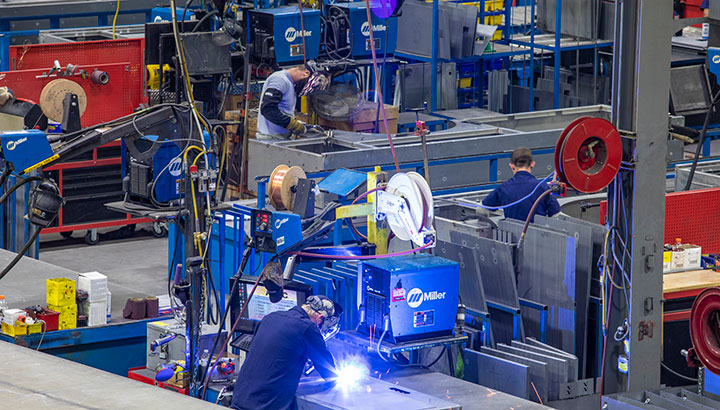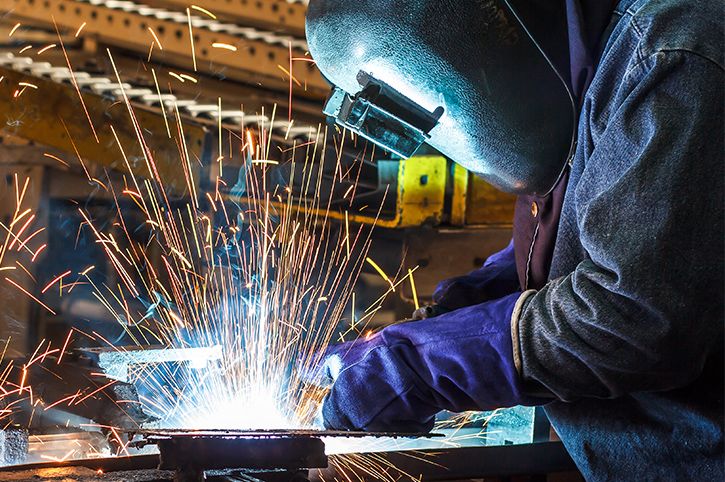Common Welding Repair Service Issues and Just How to Address Them Successfully
Welding repair work commonly run into a variety of issues that can threaten the stability of the end product. Common troubles consist of insufficient infiltration, porosity, and imbalance, amongst others. Each defect presents one-of-a-kind challenges that call for details approaches for resolution. Comprehending these issues is important for welders intending to boost their outcomes and abilities. This conversation will discover these common welding repair service concerns and reliable techniques to address them.
Poor Penetration
Inadequate penetration occurs when the weld steel fails to fully fuse with the base material, leading to weak joints and possible structural failures. This concern commonly comes from not enough warm input, wrong electrode angle, or improper welding rate. Welders may come across inadequate penetration as a result of a mistake of the essential specifications for a specific material density or kind. Furthermore, contamination on the base material's surface can prevent effective bonding, worsening the issue. To attend to poor penetration, welders need to assure ideal setups on their devices and keep a clean work surface area. Routine assessment of welds is suggested to recognize any type of deficiencies early, enabling timely corrections and the prevention of jeopardized architectural integrity in bonded assemblies.
Porosity
Porosity is a typical problem in welded joints that shows up as tiny gas bubbles entraped within the weld metal. This problem can compromise the integrity of the weld, causing lowered toughness and potential failure under tension. Fabrication. Porosity normally develops from contamination, dampness, or improper welding methods, which allow gases to get away into the liquified weld pool. To address porosity, welders must ensure appropriate surface area preparation, maintain a tidy workplace, and utilize appropriate welding parameters. Furthermore, choosing the ideal filler material and protecting gas can mitigate gas entrapment. Normal inspection and testing of welds can assist identify porosity early, assuring timely rehabilitative activities are taken, thus preserving the high quality and dependability of the bonded framework
Misalignment
Imbalance in welding can develop from different elements, including improper arrangement and thermal development. Comprehending the origin causes is important for efficient resolution. Numerous adjustment strategies are offered to straighten parts and guarantee architectural stability.
Root causes of Imbalance
Welding misalignment typically originates from a variety of underlying problems that can endanger structural integrity. One key cause is inappropriate fit-up of components prior to welding, which can bring about spaces and unequal surface areas. Variants in thermal development during the welding process can also cause distortion, specifically if the materials being signed up with have different coefficients of expansion. In addition, poor fixturing and securing might stop working to hold parts firmly in location, leading to motion during welding. Badly conserved equipment, including welding machines and tools, may introduce variances in the weld grain, additional adding to misalignment. Driver mistake, stemming from not enough training or experience, can also play a considerable role in producing misaligned welds.

Improvement Techniques Readily Available
Addressing misalignment efficiently calls for a mix of restorative techniques customized to the details concerns available. One common method is using jigs or fixtures to hold components in the right setting during welding, guaranteeing constant alignment. Additionally, pre-heating the products can help decrease distortion and improve fit-up. For substantial imbalance, mechanical adjustment techniques, such as making use of hydraulic jacks or clamps, can be employed to fix the placement before welding. Post-weld warm treatment may also be needed to eliminate stresses triggered by imbalance. Lastly, careful assessment and change during the configuration stage can stop imbalance problems from coming to be substantial issues, promoting a smoother welding process and boosting total structural integrity.
Distortion
Distortion is a common challenge in welding that can arise from different variables, consisting of uneven heating and air conditioning. Comprehending the root causes of distortion is important for carrying out efficient avoidance methods. Addressing this concern not only enhances structural integrity yet likewise improves the overall high quality of the weld.
Reasons of Distortion
When based on the intense warmth of welding, products frequently go through changes that can lead to distortion. This phenomenon mainly occurs from thermal expansion and tightening during the welding procedure. As the weld location warms up, the material expands; upon cooling, it contracts, which can produce inner anxieties. In enhancement, uneven heating throughout a workpiece can worsen these tensions, leading to bending or flexing. The kind of material likewise plays a significant function; steels with differing thermal conductivity and coefficients of development might respond differently, leading to unforeseeable distortions. Bad joint layout and inadequate fixturing can add to imbalance during welding, boosting the probability of distortion. Comprehending these reasons is important for reliable welding repair service and prevention methods.
Prevention Techniques
Effective avoidance strategies for distortion throughout welding concentrate on controlling warmth input and guaranteeing proper joint design. Preserving a consistent heat input aids to lessen thermal growth and tightening, which can lead to distortion. Using methods such as pre-heating the workpiece can also lower the temperature gradient, promoting uniform heating. Additionally, picking suitable joint layouts, such as T-joints or lap joints, can boost security and lower anxiety focus. Carrying out correct fixturing to safeguard the work surfaces in position further aids in keeping positioning throughout the welding procedure. Lastly, staggered welding sequences can distribute warmth more uniformly, avoiding localized distortion. By applying these techniques, welders can significantly decrease the possibility of distortion and improve the total high quality of their welds.
Cracking
Breaking is a typical issue encountered in welding fixings, usually arising from different factors such as improper air conditioning rates, product choice, or insufficient joint prep work. The occurrence of cracks can significantly endanger the stability of the weld, bring about potential failings throughout procedure. To address this issue, welders must initially examine the root triggers, making sure that products are compatible and appropriately chosen for the specific application. Additionally, controlling the air conditioning price throughout the welding welding torches process is necessary; rapid cooling can induce stress and cause splitting. Appropriate joint layout and preparation additionally add to minimizing the risk. Implementing these techniques can enhance weld high quality and resilience, eventually minimizing the possibility of cracking in completed weldments.

Incomplete Blend
A considerable concern in welding fixings is insufficient fusion, which takes place when the weld metal does not adequately bond with the base product or previous weld passes - Montana Mobile Welding and Repair. This issue can lead to weak points in the joint, possibly jeopardizing the stability of the bonded framework. Factors adding to insufficient blend consist of inadequate warm input, inappropriate welding strategy, and contamination of the surface areas being signed up with. To resolve this problem efficiently, welders need to assure correct pre-weld cleaning and surface prep work, as well as change their welding specifications to attain ample infiltration and fusion. Routine assessment during the welding procedure can likewise assist recognize incomplete combination early, enabling for timely corrective steps to boost the general high quality of the weld
Overheating
While welding repair services can improve structural integrity, overheating presents a considerable challenge that can lead to product degradation. Excessive heat during welding can change the mechanical buildings of metals, resulting in decreased toughness, increased brittleness, and bending. This sensation is particularly vital in high-stress applications where architectural integrity is paramount. Determining overheating can include aesthetic examinations for discoloration or distortion, in addition to monitoring temperature during the welding procedure. To mitigate the dangers linked with getting too hot, welders ought to use suitable methods, such as regulating warmth input, matheson welding readjusting traveling speed, and using suitable filler products. In addition, carrying out pre- and post-weld warm treatments can aid bring back product residential or commercial properties and boost the total quality of the repair, making sure long-lasting efficiency and safety.
Regularly Asked Questions
What Are the Common Indicators of a Welding Defect?

How Can I Examine My Welds for High quality?
To examine welds for quality, one can make use of aesthetic inspections, ultrasonic screening, and radiographic methods. Each method assures structural honesty, recognizes flaws, and verifies adherence to defined standards, ultimately boosting the integrity of the bonded joints.
What Safety and security Preventative Measures Should I Take While Welding?
When welding, one need to prioritize security by using appropriate personal safety tools, ensuring appropriate ventilation, safeguarding flammable products away, preserving a clean office, and being aware of surroundings to stop mishaps and injuries.
Can I Fix a Weld Without Renovating the Entire Joint?
Repairing a weld without redesigning the whole joint is possible, depending upon the damage (Montana Mobile Welding and Repair Belgrade Welding). Techniques such as grinding, adding filler product, or utilizing a welding procedure can successfully resolve certain imperfections while preserving the surrounding structure
What Tools Are Important for Reliable Welding Services?
Important devices for efficient welding repair work include a welding equipment, wire brush, mill, protective gear, clamps, and filler materials. Each device plays a vital role in ensuring high quality and safety throughout the repair service process. Porosity commonly occurs from contamination, moisture, or improper welding techniques, which enable gases to escape right into the molten weld swimming pool. Badly kept equipment, including welding makers and devices, might introduce incongruities in the weld bead, further contributing to misalignment. When subjected to the extreme warmth of see it here welding, products commonly undertake changes that can lead to distortion. Cracking is an usual problem experienced in welding repairs, commonly resulting from numerous aspects such as inappropriate cooling prices, product option, or insufficient joint prep work. A considerable concern in welding repairs is insufficient blend, which takes place when the weld steel does not effectively bond with the base material or previous weld passes.